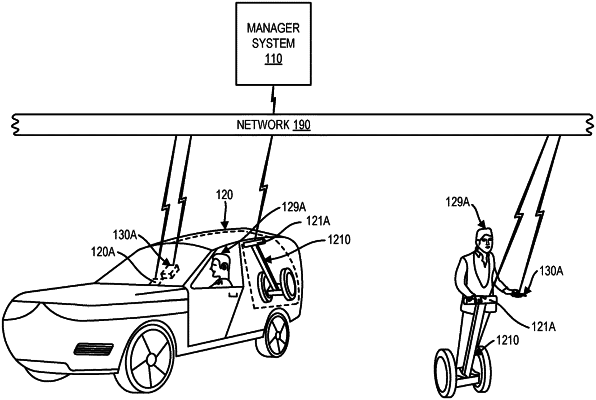| CPC G01C 21/3423 (2013.01) [G01C 21/3484 (2013.01); H04W 4/029 (2018.02); G01C 21/3685 (2013.01)] | 17 Claims |

|
1. A computer implemented method comprising:
determining a current transportation mode of a user with use of data of a user passenger vehicle associated to the user and data of a user auxiliary passenger vehicle associated to the user, wherein the user passenger vehicle is capable of carrying the user auxiliary vehicle, and wherein the user auxiliary vehicle is configured to be hand carried by the user;
evaluating a current route of the user in dependence on the current transportation mode of the user as determined by the determining; and
providing one or more output in dependence on the evaluating, wherein the method includes iteratively performing the determining and the evaluating,
wherein:
the evaluating during a first earlier instance of the evaluating includes updating the current route of the user as a single mode user passenger vehicle transportation route, and wherein
the evaluating during a second later instance of the evaluating includes updating of the current route of the user as a multimode transportation route in which the user travels partially in a user passenger vehicle transportation mode and partially in a user auxiliary vehicle transportation mode,
wherein the iteration includes (i) evaluating candidate routes commencing from a current location of the user, and (ii) selecting one of the candidate routes from (i), wherein the evaluating of candidate routes (i) includes applying a criteria having one or more factor selected from the group consisting of RF1, RF2, RF3, and RF4, where RF1 is a predicted destination arrival time associated with each respective candidate route of the candidate routes, where RF2 is a predicted comfort level associated with each respective route of the candidate routes, in dependence on a predicted comfort level of the user when travelling according to the respective candidate route, where RF3 is a predicted physical exhaustion factor associated to the route in dependence on a predicted physical exhaustion level of the user when travelling according to the candidate route, and where RF4 is a current route factor which biases the selection of candidate routes in favor of re-selecting a current route.
|